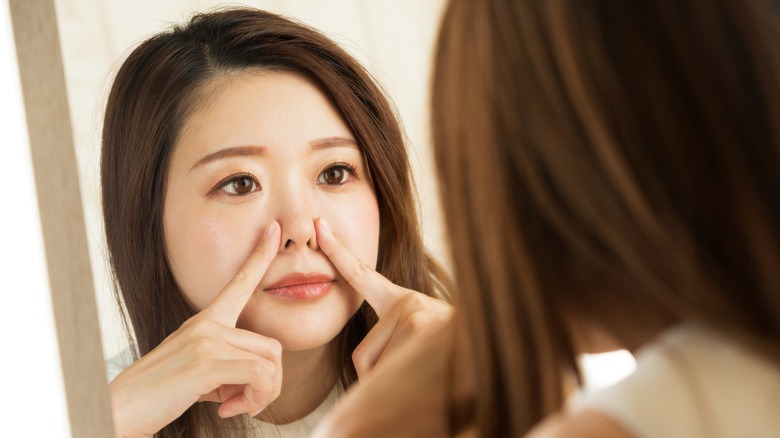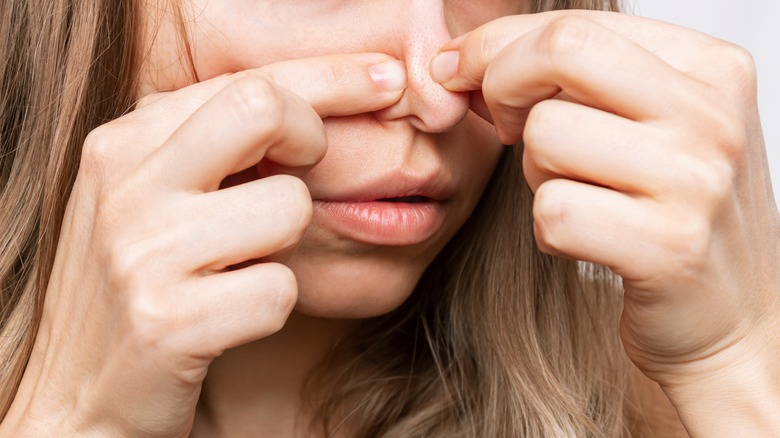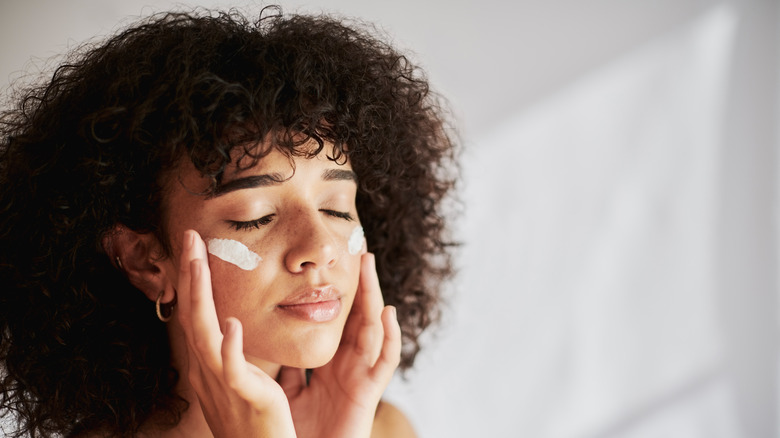Why Squeezing Your Nose Pores Is A Bad Idea
If you own a vanity mirror that magnifies all of your features, you've probably noticed the pores on your nose. How can you not? The pores in this area are larger, and when you look closely, you might also see some gunk in there that resembles blackheads. While it might be tempting to squeeze out whatever seems to fill up those pores, it's best to avoid this habit, as squeezing can irritate or damage your skin, according to Healthline.
Furthermore, what you think you're squeezing out (dirt, debris, and blackheads) might not be those at all. They are most likely sebaceous filaments. "Sebaceous filaments are naturally occurring, tube-like structures that line the walls of your pores," esthetician Renée Rouleau explained to Byrdie. Their purpose is to direct oil flow." These structures transport the sebum that your skin produces to the surface where it can moisturize and protect your skin.
Unlike blackheads, sebaceous filaments are usually colorless or yellow in hue. It's important to note that sebaceous filaments are not a type of acne, whereas blackheads are. Blackheads occur when sebum and dead skin cells clog the pores and come into contact with air, turning dark due to oxidation. So, is it okay to squeeze the blackheads on your nose then?
Squeezing your nose pores is never the answer
According to skincare experts, it is best to leave your pores, nose, and skin untouched. This means resisting the urge to pick, squeeze, or pinch your nose, as engaging in these activities (no matter how satisfying they may feel at the time) could lead to even more issues. "If you squeeze your blackheads, you can cause the follicle to rupture and induce the formation of an inflammatory lesion, or cyst," dermatologist Dr. Kathleen Cook Suozzi told Everyday Health. But the potential consequences don't end there.
"If you constantly squeeze your pores, the wear and tear of squeezing will eventually make your pores bigger over time, so I don't usually recommend this method," board-certified dermatologist and founder of Idriss Dermatology in New York Dr. Shereene Idriss shared with Cosmopolitan. Instead, dermatologists recommend a hands-off approach.
Rather than using your fingers as extraction tools, it is more effective to follow a proper skincare routine to address concerns about what is inside your pores, such as sebum and dead skin buildup. You'll also want to forgo the pore strips and pore vacuums, as they only provide temporary solutions. Sebum will naturally accumulate again, and these methods can potentially harm your skin if used repeatedly.
Focus on cleansing, exfoliation, and sun protection
The key to minimizing the appearance of sebaceous filaments (and even blackheads) is to wash your face gently, without scrubbing, using a cleanser that contains salicylic acid, benzoyl peroxide, or tea tree oil, as recommended by Medical News Today. These ingredients work differently but ultimately help regulate the amount of sebum in your pores.
Establish a regular face-washing routine, twice a day. You can also incorporate exfoliation into your routine to improve the appearance of sebaceous filaments and blackheads. "AHAs, such as glycolic and lactic acid, exfoliate the skin by removing dead skin cells. Beta-hydroxy acids (BHAs), like salicylic acid, are lipophilic, allowing them to mingle with oil deep within the pore and break up oil plugs," double board-certified dermatologist at MDCS Dermatology in New York City Brendan Camp informed Byrdie.
When choosing skincare products, opt for moisturizers, cleansers, and other products labeled as oil-free or non-comedogenic. Additionally, don't forget to protect your skin from the sun. UVA and UVB rays, along with other factors like age, can contribute to weakened or damaged pores, as mentioned by dermatologist and author Dr. Howard Murad (via Marie Claire). Speaking to Cosmopolitan, board-certified dermatologist Dr. Courtney Rubin also recommended using retinoids, as they "address the root cause of pore congestion." However, be cautious when purchasing topical treatments, which can cause irritation, especially initially. It may be best to consult your dermatologist before incorporating these skincare products into your routine.



